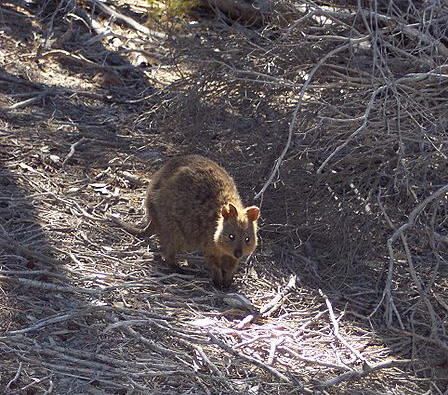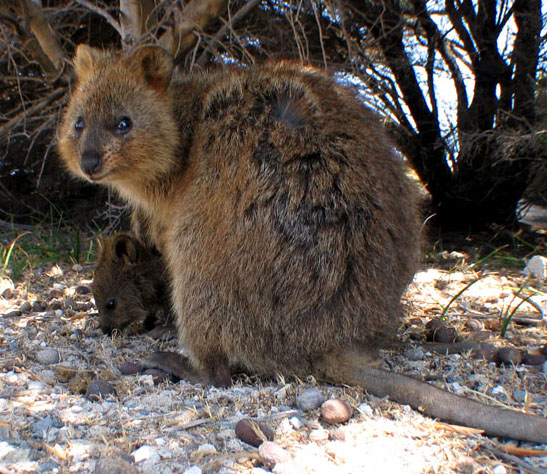Adaptation
The quokka has developed adaptions to help it survive. Having
a light brown fur coat allows it to hide from predators in the
long grasses. While this is a nocturnal animal, like the
grey wolf, they
 stay in the vegetation during the day in
order to hide from predators and the hot sun. Since quokkas are
in a hot, dry climate, they have adapted to that as well. They
can go long periods of time without water and even have the
ability to drink salt water! Quokkas have also been known to
extract water from cacti. These abilities are helpful for when
no fresh water is available to them. These animals hide in the vegetation during
the day, which is most commonly located next to a
stream. In this vegetation they create pathways and trails.
Quokkas use these to gather food and escape predators (Packer
1969).
stay in the vegetation during the day in
order to hide from predators and the hot sun. Since quokkas are
in a hot, dry climate, they have adapted to that as well. They
can go long periods of time without water and even have the
ability to drink salt water! Quokkas have also been known to
extract water from cacti. These abilities are helpful for when
no fresh water is available to them. These animals hide in the vegetation during
the day, which is most commonly located next to a
stream. In this vegetation they create pathways and trails.
Quokkas use these to gather food and escape predators (Packer
1969).
Being macropod marsupials, quokkas are able to move around by bounding and
hopping like the
red kangaroo. They also have the ability to climb trees, if
necessary, to reach food sources. The peak time of activity for the
quokka is around sunset and just before the sun rises (Packer 1969).
Activity is relatively low throughout the day, especially on hot,
dry days, because they are nocturnal. These animals also have
differing activity levels depending on what the weather is like.
Heavy rainfall corresponds with high levels of activity. While the
level of activity may be high, quokkas prefer clear, cool nights.
Under these conditions, their activity is highest (Packer 1969).


The pouches that hold the baby joeys until they are matured, at one year old, are an important feature of the quokka. The mother is able to provide food, shelter, and warm to her offspring immediately after giving birth because of this pouch. After the baby joey leaves the pouch, he/she still relies on the mother for milk for 1 - 2 months (Nocon 2003).
While being in extreme conditions, the quokka has adapted to high temperatures - they can survive up to 44 degrees Celsius or 111.2 degrees Fahrenheit! (Hayward 2008) Being nocturnal allows helps them live in hot climates because they only really expend energy during the cooler nights. Also, the ability to obtain water from odd sources (salt water and cacti) helps them survive an extreme environment. Besides their water intake adaptions, they also have developed feeding adaptions. Quokkas are able to reprocess their wastes and reuse the products found in it (Packer 1969). Pretty gross to think about, but it's also very resourceful of them!
Check this website out for even more information on adaptations!
Want to learn how these cute animals get their food? Head on over to the Nutrition page!
